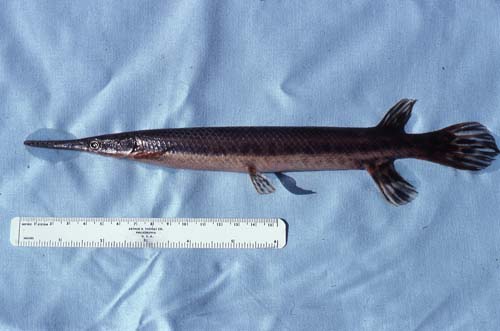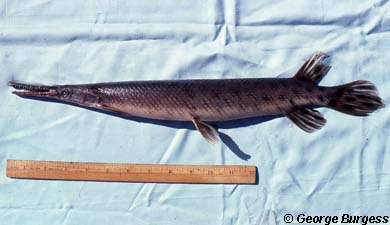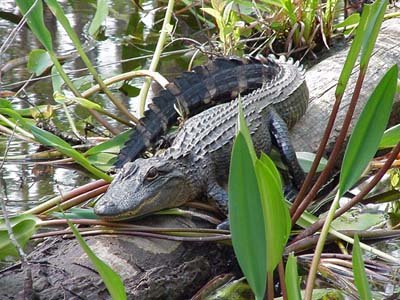Florida Gar

Lepisosteus platyrhincus
These are the smaller fish in the gar family, growing to about 34 inches on average. They inhabit the streams and lakes of Florida and lower Georgia, preferring muddy bottoms and vegetation to ambush prey. Their small fins are set far back on their elongated torpedo-shaped bodies that start with a pointed, toothy snout and end with an irregular caudal (tail) fin. They are not particularly valued for recreational fishing, and their roe is toxic to humans, so they are only threatened by habitat loss.
Order – Lepisosteiformes
Family – Lepisosteidae
Genus – Lepisosteus
Species – platyrhincus
Common Names
The English language common name is Florida gar. Other common names include Florida-pansergedde (Danish), Floridabengädda (Swedish), and Floridanluuhauki (Finnish).
Importance to Humans
The Florida gar is not normally considered a sport fish but it commonly takes a hook and produces a worthy fight on light tackle. Gars are only occasionally eaten and there is no market for their flesh. Because of their ravenous feeding habits, Florida gars sometimes are blamed for poor fishing. The gar’s sharp teeth and bony jaws often force anglers to opt to use a wire leader while using shredded nylon floss to entangle the gar’s teeth. Another fishing method uses a baited wire noose that is pulled tight over the jaws once the gar has nosed its way towards the bait.
This fish is often seen in public aquaria , however it is unsuitable for home aquariums due to its large size and large tank requirements.
Conservation
> Check the status of the Florida gar at the IUCN website.
The IUCN is a global union of states, governmental agencies, and non-governmental organizations in a partnership that assesses the conservation status of species.
Geographical Distribution

Florida gar are found from the Ocklockonee River drainage, Florida and Georgia, southward through peninsular Florida and northward to Savannah River drainage, Georgia.
Habitat
Florida gars are common in medium to large lowland streams, canals, and lakes with mud or sand bottoms and an abundance of underwater vegetation. They often congregate in spring-fed rivers of Florida. This is in contrast to their close relative, the longnose gar (L. osseus) that often cruise open water.
Biology

Distinctive Features
The gar’s body is covered with enamel-hard, diamond-shaped plates called ganoid scales. The American Indians once used the dried hides of the Florida gar for goods and the scales as arrowheads. The Florida and spotted gars are distinguishable from each other primarily by the snout length. The distance from the front of the eye to the back of the gill cover is less than 2/3 the length of the snout in the Florida gar, while it is more than 2/3 of the length in the spotted gar. The Florida gar lacks bony scales on the throat.
The snout is elongated, with the nostrils located at the tip. The gar breathes with its gills and with its special lunglike air bladder. Due to the highly vascularised air bladder that is connected to its throat, the gar may survive in hot, stagnant waters that might not have sufficient oxygen for most other species of fish.

Coloration
Florida gars have irregular round, black spots on the top of the head and over the entire body and fins. Their coloration is olive-brown along the back and upper sides with a white-to-yellow belly. The young may have dark stripes along back and sides.
Dentition
The Florida gar has a broad snout with a single row of irregularly spaced canines on the upper and lower jaws.
Denticles
Gars, as well as bowfins, paddlefishes, and sturgeons, have thick ganoid scales. These scales tend to be diamond-shape and are interlocking. Each scale consists of a bony base layer and an outer layer of ganoine which is an inorganic bone salt. The main purpose of ganoid scales is “armored” protection against predators.
Size, Age & Growth
Florida gars are thought to grow rapidly. Adult size is approximently 13- 34 inches (.33-.86 m) total length. The maximum size recorded is 52.4 inches (1.33 m TL). The Florida all-tackle record Florida gar weighted 7 pounds (3.2 kilograms). Females reach larger sizes than males.
Food Habits
Young Florida gars feed on zooplankton, insect larvae and small fish. Adults feed primarily on fish, along with some crustaceans and insects. The gar floats silently near the surface of the water, disguised as a stick or log. When it comes upon a fish, it propels itself slowly forward with a flick of its fins. Once into position the gar snaps its head sideways and secures the prey with its sharp teeth, then it slowly repositions the fish so that it can be swallowed headfirst.
Reproduction
Florida gar spawn mostly during the months of April and May, but spawning may continue into October. Nests are not built; instead the female spawns by distributing her adhesive eggs in shallow pools, weedy backwaters, or shallow riffles. The eggs are greenish-colored and are fertilized by two or more attending males.
The newly hatched larva has an adhesive disc on the front of the blunt snout, which it uses to attach itself to gravel or vegetation. The larva remains attached until reaching an approximate length of ¾ inches. As a juvenile, the gar has a fragile fin that extends along the upper edge of the tail and vibrates constantly. The fin is lost during the first year of life.

Predators
Florida gar eggs are highly toxic to humans and animals, including birds. However, the juveniles are susceptible to a variety of fish and bird predators. Adults fall prey to alligators (Alligator mississippiensis).
Parasites
The cestode Perezitrema singularis has been recorded as an intestinal parasite of the Florida gar.
Taxonomy
In 1842, DeKay described the Florida gar as Lepisosteus platyrhincus. Synonyms for this species include Cylindrosteus megalops Fowler 1911. The genus name, Lepisosteus, is derived from the Greek “lepis” meaning scale and “osteon” meaning bone; bony scaled.
Prepared by: Cathleen Bester